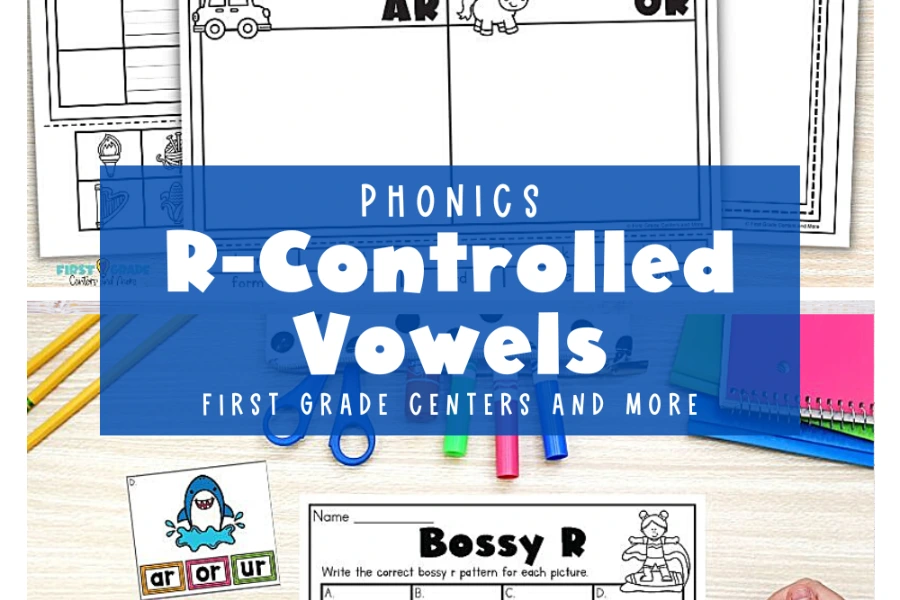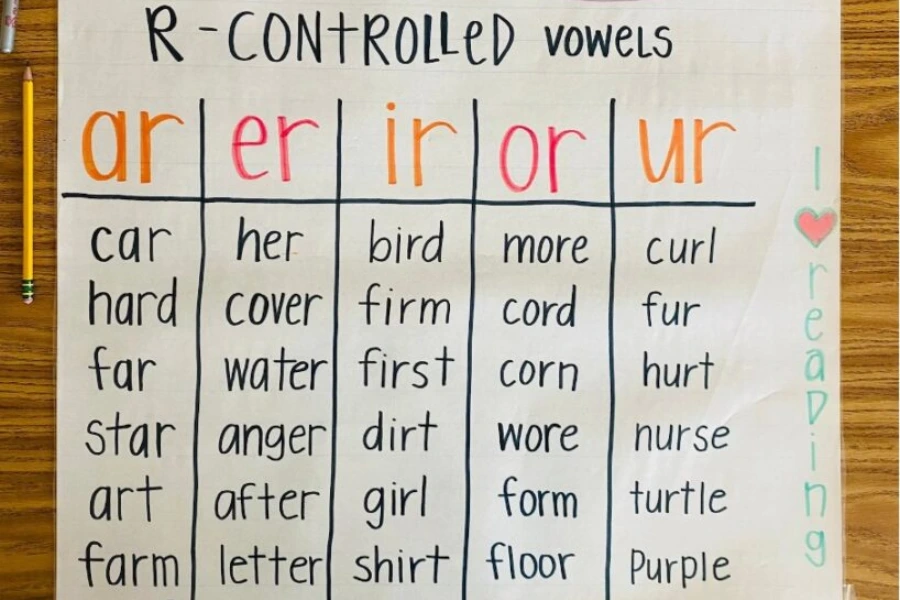
Source: firstgradecentersandmore
You’ve taught your students about short vowel sounds and long vowel sounds with their working, and their patterns. But have you introduced R Controlled Vowels? A ‘R Controlled vowel’ is when the letter “r” immediately follows a vowel resulting in a modification in vowel sound. It doesn’t sound like a usual long or short vowel anymore, making it tricky for young learners to grasp.
In this blog, we’ll discover what makes vowels unique and strategies to help students comprehend and develop a strong command over these sounds. Let’s dive deep into each of these vowel combinations to make introducing them easier and more effective.
What Is an R Controlled Vowel?
A R Controlled Vowel occurs when a vowel is followed immediately by the letter “r,” causing the vowel sound to change. This unique combination creates a sound where the vowel is no longer pronounced as a short or long vowel. Instead, the “r” controls how the vowel is heard, making these combinations an important part of phonics instruction for early learners.
R Controlled Vowel Sounds
Some of the most familiar R Controlled Vowel Sounds are:
- ar as in car or star
- er as in her or term
- ir as in bird or shirt
- or as in fork or storm
- ur as in turn or curl
These combinations can be tricky for students because the sounds created by these vowels followed by “r” often do not follow the typical long or short vowel rules.
Representation of R Controlled Vowel
The Representation of R Controlled Vowels in words is essential for students to recognize spelling patterns. In a R Controlled Vowel, a vowel always comes before the ‘r’ and the vowel sound integrates with the ‘r’ to create a unique sound. For example, in the word ‘jar,’ the ‘a’ does not sound like a short or a long ‘a’. Instead, it unites with the ‘r’ to produce its sound. It’s important to highlight these vowel-r pairs as separate from other phonics rules during lessons.
R Controlled Vowels: Teaching Techniques
R Controlled Vowels: Teaching Techniques can be simplified by breaking the sounds into manageable steps for young learners.
Here are some effective techniques:
Introduce vowel-r pairs one at a time
Concentrate on one sound at a time (e.g. ‘ar’) and provide word examples that feature that sound.
Use visual aids
Displaying words with the vowel-r combinations helps students identify patterns.
Sound comparison
A comparative study vowels sounds (e.g. car) with the standard vowels (e.g. cat).
Practice decoding words
Encourage students to break down words to hear how the “r” changes the vowel sound.
Activities for the R Controlled Vowels
Engaging students with hands-on activities will reinforce their understanding of vowels.
Activities for the R Controlled Vowels:
Word sorting
Give students a list of words and have them sort them by vowel-r combinations.
Matching games
Create cards with words and their corresponding vowel-r sounds for students to match.
Sentence building
Have students create sentences using words with vowels to practice context.
Phonics songs
Using appealing phonics songs with R Controlled vowel sounds can be helpful.

Source: pinterest
List of R Controlled Words for Kindergarteners
List of R Controlled Words for Kindergarteners:
- ar: car, jar, star
- er: her, fern, clerk
- ir: bird, sir, shirt
- or: corn, fork, storm
- ur: fur, curl, turn
This List of R Controlled Words for Kindergarteners helps them advance their phonics knowledge, and gain confidence in recognizing and using these words in their day-to-day reading and writing.
Phonics Teacher Training Course
A Phonics Teacher Training Course boosts educators’ skills for developing linguistic proficiency in children using letters and sounds. This course equips teachers with the approaches and tactics needed to make phonics engrossing and effective for young learners.
A Phonics Teacher Training Course typically includes:
- Understanding phonics rules and sounds
- Methods to teach consonants, vowels, and blends
- Techniques for teaching vowels and other phonics sounds
- Developing lesson plans and activities
- Assessment strategies to track student progress
Trained phonics teachers are equipped to:
- Provide systematic teaching that builds foundational literacy skills
- Use proven techniques to help struggling readers
- Create a controlled learning environment that encourages phonological awareness.
Vidhyanidhi Education Society (Govt. Regd.) provides an outstanding Phonics Teacher Training Course that helps ambitious educators build a flourishing career in phonics teaching. This Phonics Teacher Course covers everything from phonics basics to advanced strategies and R Controlled Vowels, ensuring that teachers leave with the strategies needed to help children succeed in reading. Vidhyanidhi Education Society (Govt. Regd.) Phonics Teacher Training Course also incorporates applicable classroom exercises and techniques for teaching intricate phonics concepts like R Controlled Vowels, etc.
With this course, teachers can confidently implement phonics instruction that enhances literacy outcomes for their students.
Ready to inspire? Join VES Phonics Course and make reading magic happen!
For more details of Phonics Course Call / Whatsapp +919869866277/+919869546913
To Download Brochure of Phonics Course, Click Here!
Phonics Course
FAQs
What is the difference between bossy R and R controlled vowels?
Both terms refer to the same concept. "Bossy R" is a fun way to convey how the letter R modifies a vowel's sound when it follows it, making the vowel neither long nor short.
How do you teach R controlled vowels to children?
Use engaging visuals, songs, and rhymes to show how R changes vowel sounds. Motivate them to focus on the new sounds through fun games and repetitive reading exercises.
How to be a Phonics Teacher?
Enroll in Vidhyanidhi Education Society's Phonics Course for adept training, covering elemental techniques and materials to teach phonics effectively to children.



